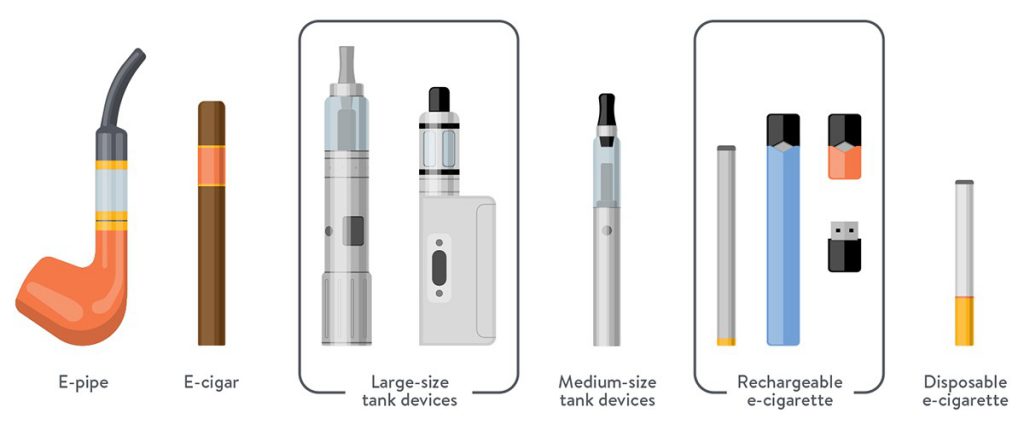Vaping and Dabbing Alert
For information on Maryland-based illnesses related to vaping, please visit the Maryland Department of Health’s Vaping Illness page.
The CDC has issued the following recommendation after recent cases of severe pulmonary disease linked to electronic cigarette use: While this investigation is ongoing, consider not using e-cigarette products. If you do use e-cigarette products and you experience symptoms like those reported in this outbreak, seek medical care promptly. The CDC and the FDA will continue to alert the public throughout this investigation. Regardless of the ongoing investigation, youth and young adults should not use e-cigarette products. Women who are pregnant should not use e-cigarette products. Adults who do not currently use tobacco products should not start using e-cigarette products. For more information including symptoms and cases, visit https://www.cdc.gov/tobacco/basic_information/e-cigarettes/severe-lung-disease.html
What is Vaping?
- “Vaping” is the use of an e-cigarette to inhale an aerosol that contains nicotine, flavorings, and other chemicals.
- E-cigarettes can look like cigarettes, cigars, pipes or even everyday objects like pens or USB flash drives. Other devices, such as those with fillable tanks, may look different.
- E-cigarettes can also be used to vape marijuana – the dried plant, concentrated wax called “dabs,” or THC and CBD oils. THC is the chemical that causes many of the drug’s mind-altering effects.
- E-cigarettes can also be used to vape other drugs.
- Some teens use e-cigarettes for “dripping” – putting e-liquid drops directly onto heated coils of the device. This produces thicker smoke but also higher levels of nicotine and toxins.
What is JUULing?
- JUULing is the use of a JUUL brand of e-cigarette that is shaped like a USB flash drive.
- JUUL heats a nicotine liquid to make an aerosol that is inhaled.
- Since JUUL became popular there are many copycat types of pod type vaping devices which may look like USB flash drives, lighters or other small devices and can be charged in a USB port.
- These pod style e-cigarettes have a high level of nicotine.
- Most pods have the nicotine equivalent of more than one pack of cigarettes in one pod.
- Unlike a cigarette, a user may not know how much nicotine they are getting until they start to feel sick.
What is Dabbing?
- “Dabbing” is another word for smoking or vaping THC extracts from marijuana.
- Names for these THC extracts include hash oil or honey oil, wax, budder, and shatter.
- These extracts are concentrated and vaping them can deliver very large amounts of THC, so the side effects of dabbing are often more powerful than those from smoked marijuana.
- THC vaping has sent some people to the emergency room.
- Higher THC levels may also mean a greater risk for addiction.
Potential Risks
- Vaping and dabbing are not considered safe for teens and young adults. Young adults who use marijuana or nicotine in any form are at risk for long-lasting effects.
- Adolescent brains are still developing. Nicotine and marijuana affect parts of the brain that control attention and learning. Other risks include mood disorders and permanent problems with impulse control.
- Nicotine and marijuana also affect the development of the brain’s reward system, so use can lead to addiction and use of other drugs. Younger people are at higher risk of addiction and other drug use.
- The FDA is investigating reports of seizures after e-cigarette use, especially in young adults.
- More recently there have been cases of severe lung disease which is also being investigated.
- Nicotine liquid used in the devices is toxic and can poison young children and pets.
How to Talk to Your Children about Vaping/Dabbing and E-Cigarettes
- Know the Facts: Click the links below for science-based information about the real risks of youth e-cigarette use.
- Be Patient and Ready to Listen: Avoid criticizing or lecturing your child, and encourage an ongoing open discussion.
- Look for Opportunities to Start the Conversation: such as when seeing an advertisement for e-cigarettes
- Answer Their Questions: Have some answers ready for questions like “Why don’t you want me to use e-cigarettes?”, “I thought e-cigarettes didn’t have nicotine?”, and “What’s the big deal about nicotine?”
- Keep the Conversation Going: Encourage teens to learn the facts about e-cigarettes and continue making healthy choices, and remind teens of the risks to their health.
- Parents can text QUIT to 202 879-7550 to learn more about helping your teen quit vaping.
More Tips for Talking to Kids about Substance Use:
- E-cigarettes and Youth: What Parents Need to Know http://www.CDC.gov/e-cigarettes
- How to Talk with Your Kids About Vaping https://drugfree.org/article/how-to-talk-with-your-kids-about-vaping/
- “Talk. They Hear You.” Parent resources for talking to kids about the dangers of alcohol and other drugs – https://www.samhsa.gov/underage-drinking/parent-resources
- Guiding Good Choices and Staying Connected With Your Teen: free evidence-based parent and family education programs offered by the Carroll County Health Department https://cchd.maryland.gov/behavioral-health-alcohol-and-drug-use-prevention-services/
- Look for Warning Signs of Substance Use: https://drugfree.org/article/look-for-warning-signs/
- What To Do If You Think Your Child Is Using Drugs: https://drugfree.org/parent-blog/what-to-do-if-you-think-your-child-is-on-drugs/
Sources – Learn More about the Risks of E-Cigarettes for Young People
- https://www.cdc.gov/tobacco/basic_information/e-cigarettes/Quick-Facts-on-the-Risks-of-E-cigarettes-for-Kids-Teens-and-Young-Adults.html
- https://www.drugabuse.gov/publications/drugfacts/electronic-cigarettes-e-cigarettes
- https://www.drugabuse.gov/publications/drugfacts/marijuana
- https://drugfree.org/drug/e-cigarettes-vaping/
- https://drugfree.org/article/how-to-talk-with-your-kids-about-vaping/
- https://drugfree.org/parent-blog/know-kid-vaping-marijuana/
- https://www.getsmartaboutdrugs.gov/content/teens-and-vaping
Updated September, 2019
Print this fact sheet: Vaping, Dabbing Advisory Update 9.2019

